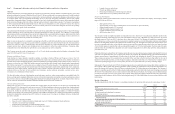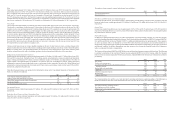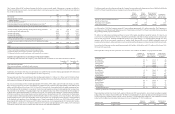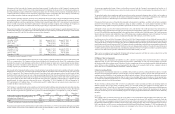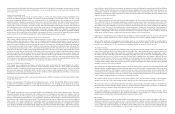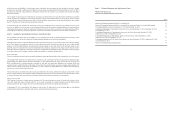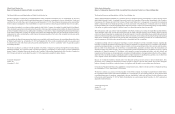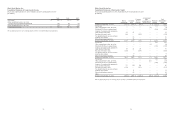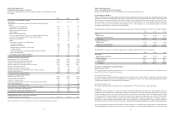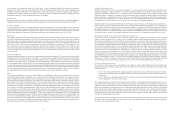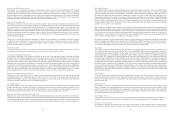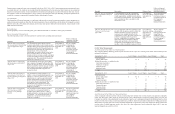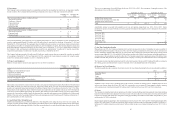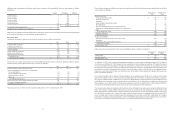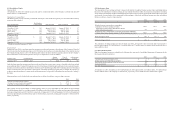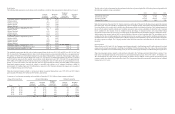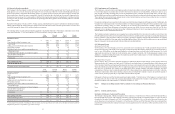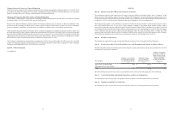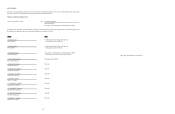Whole Foods 2015 Annual Report Download - page 26
Download and view the complete annual report
Please find page 26 of the 2015 Whole Foods annual report below. You can navigate through the pages in the report by either clicking on the pages listed below, or by using the keyword search tool below to find specific information within the annual report.39
the cost method of accounting and classified as “Other assets” on the Consolidated Balance Sheet. Under the cost method,
investments are carried at cost and are adjusted only for other-than-temporary declines in fair value, certain distributions, and
additional investments. Additionally, the Company holds certain equity interests accounted for using the equity method of
accounting. The Company’s share of income and losses from equity method investments is included in “Selling, general and
administrative expenses” on the Consolidated Statements of Operations.
Restricted Cash
Restricted cash primarily relates to cash held as collateral to support a portion of our projected workers’ compensation obligations.
Additionally, the Company holds restricted cash as a rent guarantee on certain operating leases through fiscal year 2020.
Accounts Receivable
Accounts receivable are shown net of related allowances and consist primarily of credit card receivables, vendor receivables,
customer purchases, and occupancy-related receivables. Vendor receivable balances are generally presented on a gross basis
separate from any related payable due. Allowance for doubtful accounts is calculated based on historical experience, customer
credit risk and application of the specific identification method and was not material in fiscal year 2015 or 2014.
Inventories
The Company values inventories at the lower of cost or market. Cost was determined using the dollar value retail last-in, first-
out (“LIFO”) method for approximately 92.2% and 93.5% of inventories in fiscal years 2015 and 2014, respectively. Under the
LIFO method, the cost assigned to items sold is based on the cost of the most recent items purchased. As a result, the costs of
the first items purchased remain in inventory and are used to value ending inventory. The excess of estimated current costs over
LIFO carrying value, or LIFO reserve, was approximately $49 million and $48 million at September 27, 2015 and September 28,
2014, respectively. Costs for remaining inventories are determined by the first-in, first-out method. Cost before the LIFO
adjustment is principally determined using the item cost method, which is calculated by counting each item in inventory, assigning
costs to each of these items based on the actual purchase cost (net of vendor allowances) of each item and recording the actual
cost of items sold.
Property and Equipment
Property and equipment is stated at cost, net of accumulated depreciation and amortization. The Company provides depreciation
of equipment over the estimated useful lives (generally 3 to 15 years) using the straight-line method, and provides amortization
of leasehold improvements and real estate assets under capital leases on a straight-line basis over the shorter of the estimated
useful lives of the improvements or the expected terms of the related leases. The Company provides depreciation of buildings
over the estimated useful lives (generally 20 to 50 years) using the straight-line method. Costs related to a projected site determined
to be unsatisfactory and general site selection costs that cannot be identified with a specific store location are charged to operations
currently. The Company recognizes a liability for the fair value of a conditional asset retirement obligation when the obligation
is incurred. Repair and maintenance costs are expensed as incurred. Upon retirement or disposal of assets, the cost and related
accumulated depreciation are removed from the balance sheet and any gain or loss is reflected in earnings.
Leases
The Company generally leases stores, non-retail facilities and administrative offices under operating leases. Store lease
agreements generally include rent holidays, rent escalation clauses and contingent rent provisions for percentage of sales in
excess of specified levels. We recognize rent on a straight-line basis over the expected term of the lease, which includes rent
holiday periods and scheduled rent increases. The expected lease term begins with the date the Company has the right to possess
the leased space for construction and other purposes. The expected lease term may also include the exercise of renewal options
if the exercise of the option is determined to be reasonably assured. The expected lease term is also used in the determination
of whether a store is a capital or operating lease. Amortization of land and building under capital lease is included with occupancy
costs, while the amortization of equipment under capital lease is included with depreciation expense. Additionally, we review
leases for which we are involved in construction to determine whether build-to-suit and sale-leaseback criteria are met. For those
leases that trigger specific build-to-suit accounting, developer assets are recorded during the construction period with an offsetting
liability. Developer assets recorded as of September 27, 2015 were not material. As of September 28, 2014, the Company had
developer assets totaling approximately $67 million, with the offsetting liability included in the “Other current liabilities” line
item on the Consolidated Balance Sheets. Sale-leaseback transactions are recorded as financing lease obligations. We record
tenant improvement allowances and rent holidays as deferred rent liabilities, and amortize the deferred rent over the expected
lease term to rent. We record rent liabilities for contingent percentage of sales lease provisions when we determine that it is
probable that the specified levels as defined by the lease will be reached.
40
Goodwill and Intangible Assets
Goodwill consists of the excess of cost of acquired enterprises over the sum of the amounts assigned to identifiable assets
acquired less liabilities assumed. Goodwill is reviewed for impairment annually at the Company’s fiscal year end, or more
frequently if impairment indicators arise, on a reporting unit level. We allocate goodwill to one reporting unit for goodwill
impairment testing. A qualitative assessment, based on macroeconomic factors, industry and market conditions and company-
specific performance, is performed to determine whether it is more likely than not that the fair value of the reporting unit is
impaired. If it is more likely than not, we compare our fair value, which is determined utilizing both a market value method and
discounted projected future cash flows, to our carrying value for the purpose of identifying impairment.
Intangible assets include acquired leasehold rights, favorable lease assets, trade names, brand names, patents, liquor licenses,
license agreements, and non-competition agreements. The Company amortizes definite-lived intangible assets on a straight-line
basis over the period the intangible asset is expected to generate cash flows, generally the life of the related agreement. Currently,
the weighted average life is approximately 16 years for contract-based intangible assets and approximately two years for
marketing-related and other identifiable intangible assets. Indefinite-lived intangible assets are reviewed for impairment quarterly,
or whenever events or changes in circumstances indicate the carrying amount of an intangible asset may not be recoverable.
Impairment of Long-Lived Assets and Long-Lived Assets to be Disposed of
The Company evaluates long-lived assets for impairment whenever events or changes in circumstances, such as unplanned
negative cash flow, short lease life, or a plan to close is established, indicate that the carrying amount of an asset may not be
recoverable. Recoverability of assets to be held and used is measured by a comparison of the carrying amount of an asset to
future undiscounted cash flows expected to be generated by the asset. If such assets are determined to be impaired, the impairment
to be recognized is measured by the amount by which the carrying value of the assets exceeds the fair value of the assets. The
fair value, based on hierarchy input Level 3, is determined using management’s best estimate based on a discounted cash flow
model based on future store operating results using internal projections or based on a review of the future benefit the Company
anticipates receiving from the related assets. Additionally for closing locations, the Company estimates net future cash flows
based on its experience and knowledge of the area in which the closed property is located and, when necessary, utilizes local
real estate brokers. Assets to be disposed of are reported at the lower of the carrying amount or fair value less costs to sell. When
the Company impairs assets related to an operating location, a charge to write down the related assets is included in the “Selling,
general and administrative expenses” line item on the Consolidated Statements of Operations. When the Company commits to
relocate, close, or dispose of a location, a charge to write down the related assets to their estimated recoverable value is included
in the “Relocation, store closure and lease termination costs” line item on the Consolidated Statements of Operations.
Fair Value of Financial Instruments
The Company records its financial assets and liabilities at fair value in accordance with the framework for measuring fair value
in generally accepted accounting principles. This framework establishes a fair value hierarchy that prioritizes the inputs used to
measure fair value:
• Level 1: Observable inputs that reflect unadjusted quoted prices for identical assets or liabilities traded in active markets.
• Level 2: Inputs other than quoted prices included within Level 1 that are observable for the asset or liability, either directly
or indirectly.
• Level 3: Inputs that are generally unobservable. These inputs may be used with internally developed methodologies that
result in management’s best estimate of fair value.
The Company holds money market fund investments that are classified as cash equivalents that are measured at fair value on a
recurring basis based on quoted prices in active markets for identical assets. The Company also holds available-for-sale securities
generally consisting of state and local municipal obligations and corporate bonds and commercial paper which hold high credit
ratings. These instruments are valued using a series of multi-dimensional relational models and series of matrices with standard
inputs obtained from readily available pricing sources and other observable market data, such as benchmark yields and base
spread. Investments are stated at fair value with unrealized gains and losses, net of related tax effect, included as a component
of shareholders’ equity until realized. Declines in fair value below the Company’s carrying value deemed to be other than
temporary are charged against net earnings.
The carrying amounts of accrued payroll, bonuses and other benefits due team members, and other accrued expenses approximate
fair value because of their short maturities. Store closure reserves and estimated workers’ compensation claims are recorded at
net present value to approximate fair value.


